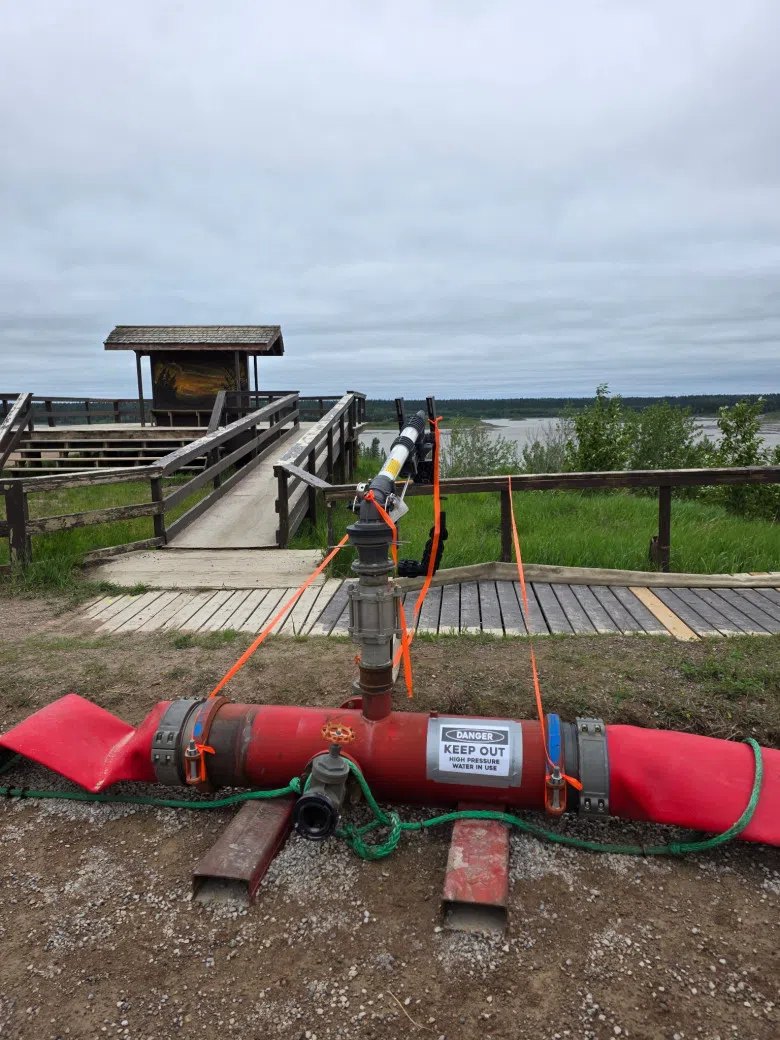
Alberta Wildfire sprinkler and structural protection system
FORT MCMURRAY, AB. — A fire ban remains in effect across most of Alberta, including the entire Regional Municipality of Wood Buffalo (RMWB), as hot and dry conditions continue to drive extreme wildfire risk.
Despite a brief reprieve from rain on Saturday, fire danger has rebounded to very high levels in the Fort McMurray Forest Protection Area. There are currently five active wildfires in the region. Three are classified as out of control, one is being held, and one is under control.
The most concerning of these is the Tulip Lake wildfire (MWF026), which has grown to an estimated 14,152 hectares. Located 15 kilometres northeast of Fort Fitzgerald and 28 kilometres east of Fort Smith, the fire is being managed by a unified command team that includes Alberta Wildfire, the Government of the Northwest Territories, and the Tthebatthı Dënesųłiné First Nation. A U.S. incident management team is en route to assist under the Northwest Compact.
“The fire has shown decreased activity over the weekend due to significant rain, cooler temperatures, and lighter winds,” Alberta Wildfire said in a statement. “Crews are taking advantage of these favourable conditions today to further secure containment lines with air and ground support.”
Structural protection efforts are underway across the region. High-volume sprinkler systems have been installed on all known buildings east of the Slave River in Alberta, with similar protections completed by the Northwest Territories government. More than 10 kilometres of sprinklers have been placed to shield the communities near Fort Smith.
To the north, wildfire MWF025 continues to burn out of control near Barrow Lake, approximately 48 kilometres north of Fort Chipewyan. The fire is now 32,759 hectares in size. While recent rain has helped limit fire behaviour, crews remain on alert and continue to maintain sprinkler protection on remote cabins.
Further west, MWF016 has reached an estimated 21,000 hectares and is located 85 kilometres from Fort McMurray. Recent rainfall has helped crews reinforce containment lines, and the fire is not currently threatening any communities.
A smaller blaze, MWF027, was detected on June 5 and is currently being held. It is burning near the Athabasca River, roughly 65 kilometres west of Fort McMurray. The fire is approximately 7 hectares in size, and firefighters are making steady progress using air and ground support.
Fire danger is even more severe further south. In the Lac La Biche Forest Area, which also falls within the RMWB, conditions are rated as extreme. A major wildfire near Conklin has now grown to nearly 67,000 hectares. The community remains under an evacuation alert.
The fire ban currently in place prohibits all outdoor wood fires, including those in designated firepits or backyards, as well as the use of charcoal briquettes, fireworks, and exploding targets. Propane fire pits and natural gas-powered appliances are still permitted.
“With warmer and drier conditions expected in the coming days, we ask that you please continue to use caution when spending time outdoors and avoid activities that could spark a new fire,” said Stephen Fudge, Alberta Wildfire Information Officer for the Fort McMurray Forest Area.
Since the start of the year, 27 wildfires have burned approximately 74,406 hectares in the Fort McMurray Forest Area.
Residents are also being urged to take extra care when using off-highway vehicles and to reduce fire risk by keeping machines clean and carrying basic firefighting tools.
Wildfire smoke continues to affect air quality across the region. Officials recommend limiting outdoor activities and monitoring health guidance. Residents experiencing respiratory difficulties are advised to call Health Link at 811.
Alberta Wildfire encourages residents to report any smoke sightings by calling 310-FIRE. For updates and safety resources, visit the Alberta Wildfire website or download the Alberta Wildfire Status app.








Comments